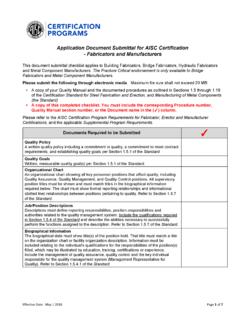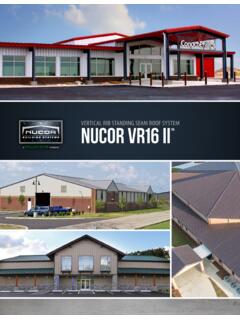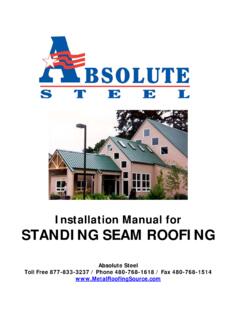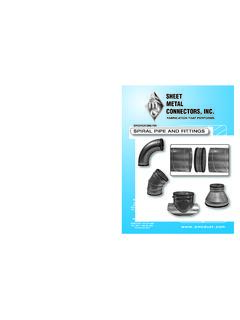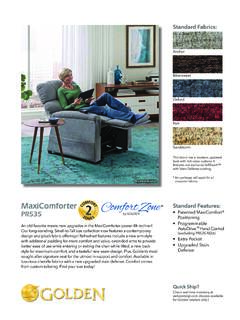Transcription of Industrial Buildings-Guidelines and Criteria - AISC
1 Industrial Buildings Guidelines and Criteria DR. JAMES M. FISHER The purpose of this paper is to provide the designer of Industrial buildings with guidelines and design Criteria for the design of buildings without cranes, or buildings with light-to-medium cranes. It would seem a simple task to design a good Industrial building. The basic ele-ments of the structure do not present a formidable design task. However, combining the elements: roof deck, pur-lins, girders, columns and girts into the most functional and cost-efficient system , is a complex task. Experience has shown the futility of strict rules where judgement still applies, , intuition can still reasonably solve multi-variable problems. However, general guide-lines and Criteria can be stated.
2 These guidelines and Criteria do not change significantly with time. The guide-lines for design can best be understood by recognizing there are interdependencies between all major compo-nents. The selection and design of the components of Industrial buildings were individually discussed in an AISC publication "Light and Heavy Industrial Buildings." Roofing, walls, metal deck, purlins, main members, col-umns, girts, bracing, anchor bolts, floor slabs, crane girders and crane columns were discussed in detail. Listed in the bibliography are references which address the de-sign of each of these components. GUIDELINES AND Criteria FOR THE "OPTIMUM" Industrial BUILDING The question "What is the 'optimum' Industrial build-ing?" is answered differently, depending on whom is asked the question.
3 To the owner, the optimum building is one that meets its intended function, one that does not leak, one with no cracks in the floor slab and one whose construction cost came in under budget. Dr. James M. Fisher is Vice President of Computerized Structural Design, Inc. and President of ECOM Associates, Milwaukee, Wisconsin. This paper, the Higgins Lectureship Award win-ner for 1984, was presented at the plenary session of the Na-tional Engineering Conference, Tampa, Florida on March 28, 1984. The engineer thinks of the "optimum" building in several ways. For example, to the young designer it is usually thought of as the building of least weight or cost that will carry intended loads, well-engineered. The senior project engineer thinks of the optimum building as one which satisfies the owner, and one for which his construction documents caused little or no confusion dur-ing construction.
4 The owner of the firm often thinks of the optimum building as one with which the client is pleased, thus paying for it promptly, and one on which his firm makes a profit on the design. Here are guidelines that should lead to an optimal building design for all parties: 1. Identification of Client Requirements The first step is to determine who is your client build-ing owner, general contractor, fabricator, construction manager, etc. Next, who are the other parties, and what are your relationships with them (they are all indirect and their input must be channeled through your client). The next step is to determine the user's requirements, beginning with the initial project meeting. At this initial meeting, it is important to spend a considerable amount of time going over a design checklist.
5 Such a list has been developed by our firm for Industrial buildings. It contains questions which must be answered to get a good start on the project. Questions are asked about the fol-lowing items: Site information Soil conditions Plant layout and work flow Preferred bay sizes Future expansion plans Loading docks Door locations Crane types and capacity Floor slabs Wall material preferences Roofing preferences HVAC equipment loads 149 Process loads Preferred fabricators/contractors Design responsibilities Schedule Payment of fees Budget The building budget and the engineering budget must be discussed at this initial meeting. With respect to the owner's budget, it is important to discuss how realistic it is. How was the budget established?
6 With what degree of sophistication was it established? Can the building be built within the budget? Has the owner included fees and engineering? It is important to determine to what extent the client wants to participate in the design process; , how often does the client intent to meet to discuss the project. Meetings are very expensive, and unanticipated meetings can and will destroy the engineer's budget. 2. Identification of Structural Requirements At this point, the engineer should list and examine ap-plicable building codes, specifications, tolerances, spe-cial loadings and stiffness requirements that have been specified or should be specified for the project. A review of the owner's Criteria to determine how they correspond with the required codes, specifications and stiffness re-quirements is necessary.
7 For example, standard mill tol-erances for beam sweep (ASTM A6) are greater than sweep tolerances allowed by many crane manufacturers for installation of crane rails. A major conflict between suppliers can be avoided if this difference is recognized early in the design stage. Office standards the design firm generally follows for specific design types should also be reviewed at this time. Special loading Criteria must be examined, , lateral guiding forces for cranes with lateral guide wheels and bumper forces (bumper forces are real and usually ex-ceed longitudinal tractive forces) should be discussed with the crane manufacturer, and these Criteria incorporated into the design. A discussion of stiffness requirements is in order at this point.
8 For most projects, it is not difficult to deter-mine strength requirements. However, stiffness require-ments are generally undefined, are not given in codes, and frequently are not specified. Stiffness can determine the success or failure of a structure. This not only applies to Industrial buildings, but also to residential and com-mercial structures. In the case of the Industrial building, and in particular the crane building, the live loads, as opposed to fictitious apparent floor loads, are process loads. Consequently, the structure will be loaded to its full design load early in its life and stiffness deficiencies will be immediately obvious. Unfortunately, the designer is likely to be on his own in selecting the stiffness required for individual compo-nents and that required for the structure in general.
9 The author's guidelines for stiffness for Industrial buildings are: Lateral Stiffness for Industrial Buildings without Cranes Lateral stiffness requirements are generally dependent upon the wall material selected for the structure. Build-ings with sheet metal wall systems have performed ad-equately with predicted wind drifts (based on the bare steel frame) as large as Height/100. Undoubtedly, the actual drift of the structure is considerably less due to the diaphragm action of walls and roof. The Canadian Institute of Steel Construction recommends lateral drift controls between H/400 and H/200 for Industrial build-ings. This same Criteria cannot be used for buildings with masonry walls. For masonry wall structures, the designer should calculate the mortar stress which would occur for a proposed building deflection.
10 The mortar stress should be kept to NCMA* allowable values. Allowable deflec-tions for buildings with precast or tilt-up wall type con-struction are dependent upon the type of connections of the concrete to the foundation as well as the connection at the eave. If rotationally flexible connections are used at the base and eave, these structures can be allowed larger deflections without a great deal of distress. Lateral Stiffness for Industrial Buildings with Cranes Drift Criteria for buildings with cranes are not only de-pendent upon the choice of wall system , but also upon crane movements. For pendent-operated type crane sys-tems, buildings with calculated wind drift ratios of H/100 have performed. However, crane movement can generally be observed.




